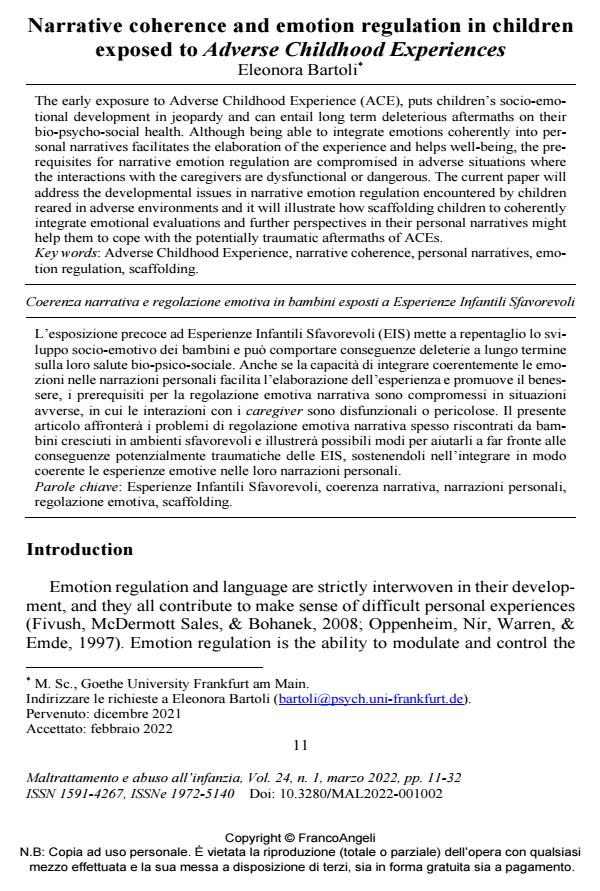Narrative coherence and emotion regulation in children exposed to Adverse Childhood Experiences
Titolo Rivista MALTRATTAMENTO E ABUSO ALL’INFANZIA
Autori/Curatori Eleonora Bartoli
Anno di pubblicazione 2022 Fascicolo 2022/1
Lingua Inglese Numero pagine 22 P. 11-32 Dimensione file 217 KB
DOI 10.3280/MAL2022-001002
Il DOI è il codice a barre della proprietà intellettuale: per saperne di più
clicca qui
Qui sotto puoi vedere in anteprima la prima pagina di questo articolo.
Se questo articolo ti interessa, lo puoi acquistare (e scaricare in formato pdf) seguendo le facili indicazioni per acquistare il download credit. Acquista Download Credits per scaricare questo Articolo in formato PDF

FrancoAngeli è membro della Publishers International Linking Association, Inc (PILA)associazione indipendente e non profit per facilitare (attraverso i servizi tecnologici implementati da CrossRef.org) l’accesso degli studiosi ai contenuti digitali nelle pubblicazioni professionali e scientifiche
The early exposure to Adverse Childhood Experience (ACE), puts children’s socio-emotional development in jeopardy and can entail long term deleterious aftermaths on their bio-psycho-social health. Although being able to integrate emotions coherently into personal narratives facilitates the elaboration of the experience and helps well-being, the prerequi-sites for narrative emotion regulation are compromised in adverse situations where the interactions with the caregivers are dysfunctional or dangerous. The current paper will address the developmental issues in narrative emotion regulation encountered by children reared in adverse environments and it will illustrate how scaffolding children to coherently integrate emotional evaluations and further perspectives in their personal narratives might help them to cope with the potentially traumatic aftermaths of ACEs.
L’esposizione precoce ad Esperienze Infantili Sfavorevoli (EIS) mette a repentaglio lo sviluppo socio-emotivo dei bambini e può comportare conseguenze deleterie a lungo termine sulla loro salute bio-psico-sociale. Anche se la capacità di integrare coerentemente le emozioni nelle narrazioni personali facilita l’elaborazione dell’esperienza e promuove il benessere, i prerequisiti per la regolazione emotiva narrativa sono compromessi in situazioni avverse, in cui le interazioni con i caregiver sono disfunzionali o pericolose. Il presente articolo affronterà i problemi di regolazione emotiva narrativa spesso riscontrati da bambini cresciuti in ambienti sfavorevoli e illustrerà possibili modi per aiutarli a far fronte alle conseguenze potenzialmente traumatiche delle EIS, sostenendoli nell’integrare in modo coerente le esperienze emotive nelle loro narrazioni personali.
Parole chiave:Esperienze Infantili Sfavorevoli, coerenza narrativa, narrazioni personali, regolazione emotiva, scaffolding.
- Autobiographical Memory and the Life Story pp.221 (ISBN:9781009492140)
- Coherence of child maltreatment narratives by emerging adults: How does child maltreatment affect how we share our story? Mariam Fishere, Tilmann Habermas, in Applied Cognitive Psychology /2023 pp.531
DOI: 10.1002/acp.4056 - Autobiographical Memory and the Life Story Tilmann Habermas, pp.377 (ISBN:9781009492140)
Eleonora Bartoli, Narrative coherence and emotion regulation in children exposed to Adverse Childhood Experiences in "MALTRATTAMENTO E ABUSO ALL’INFANZIA" 1/2022, pp 11-32, DOI: 10.3280/MAL2022-001002